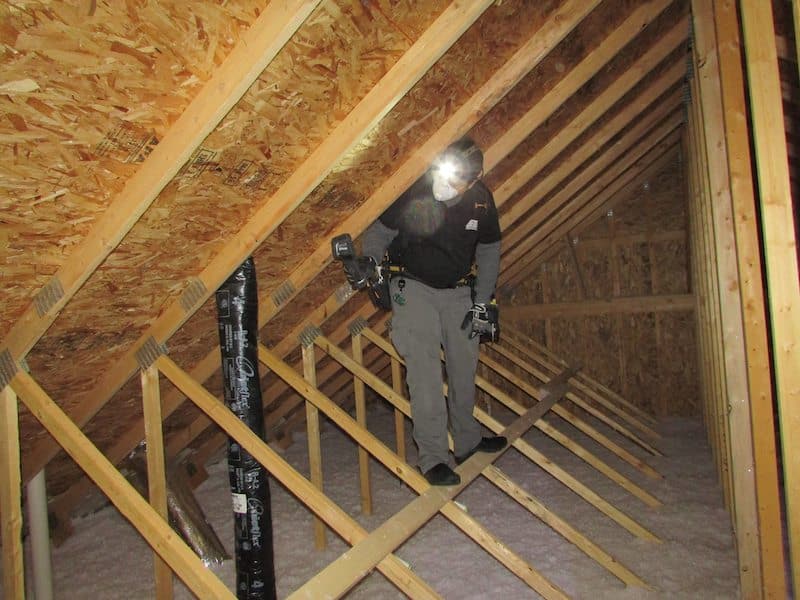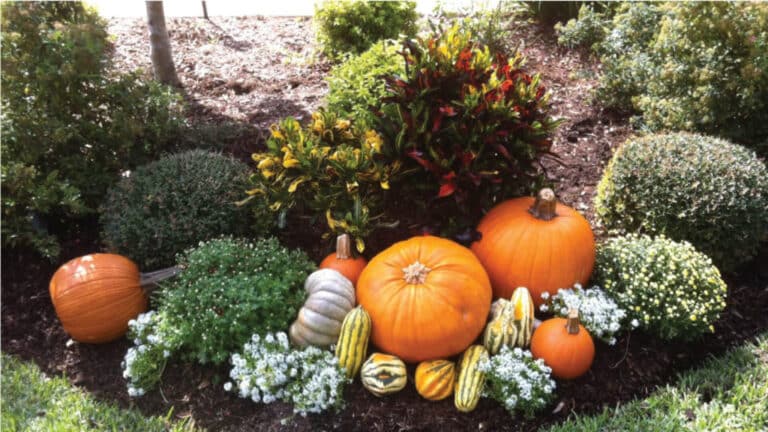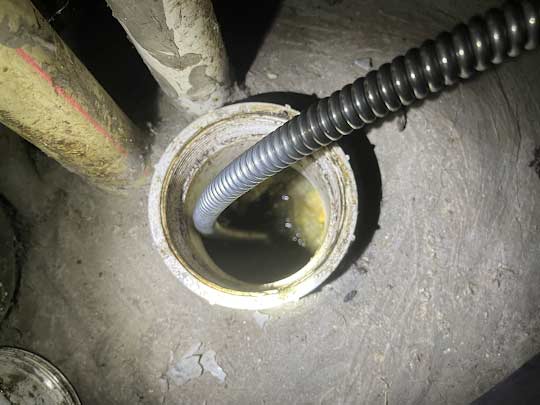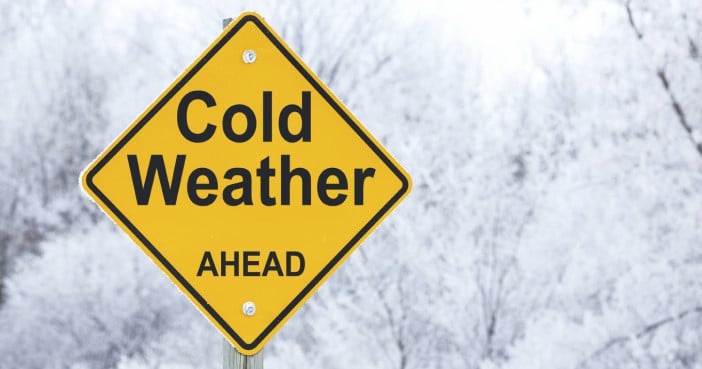Continuing from where we stopped in the last post, let’s get started with this:

Inspect the Roof and Attic
Your roof does a good job of keeping your home safe from the weather. It is important to check that it is in good shape before fall and winter get here. Start by looking over your roof to see if you find any signs of extensive damage or wear. Watch out for missing or bad shingles, cracked flashing, or places where water can get into your home.
If you feel good about being up on your roof, you can change damaged shingles or fix the flashing on your own. But, if you want a full check or work that is more tricky, it is better to call a roofing contractor. A pro can find problems that you may not see right away. This can help stop leaks and damage to the roof’s structure, which could cost more later.
Also, do not forget to look in the attic for any leaks or signs of water. You can read more on this at check your attic for signs of moisture or leaks. If the insulation in the attic is wet or harmed, the area can get mold. You can also lose energy in the home because of this. A good attic ventilation system will stop water from building up. It will also help keep the place healthy for everyone inside.

Prepare Your Garden and Lawn
Fall might feel like the time to stop thinking about your garden and lawn, but there are some important things to do to help them grow better in the spring. You can start by trimming the dead or too long branches from shrubs and trees. Pruning helps your yard look nice and clean. It also helps plants grow strong and healthy when the next year comes.
Next, think about aerating your lawn if the soil is packed down. This will help water and nutrients get into the ground better. After you aerate, put on a fall fertilizer, as this will feed your grass and make it strong for winter.
If you have a vegetable garden, pick any crops that are left. Take out old plants that are done growing. Clearing old plants away helps keep the garden safe from pests and sickness. You can also plant cover crops like rye or clover. These help the soil stay healthy and stop the dirt from washing away.

Inspect and Clean Your Siding
Your home’s siding helps keep it safe from weather. To keep it in good shape, you should check for problems like cracks, rot, or paint that is coming off. Fix these issues right away if you see them. This will stop water from getting in and causing trouble in your home’s walls.
Cleaning your siding is important to help it keep looking good and last longer. You can use a pressure washer, or you can use a hose with a scrub brush to get rid of dirt, mildew, and algae that has built up over time. For the best cleaning, try a siding cleaner that the maker of your siding recommends. A good hose can help make this job easier and faster.
For wood siding, look to see if there is any rot. Repaint it or reseal it when needed. This will help keep out water and bugs. When you take care of your siding, it will look good and make your home nice from the street. It will also last longer and protect your house for years.

Inspect and Clean Your Drains
Fall usually brings more rain, so it is important that your drainage systems be working well. Extra water can build up around the foundation of your home if your gutters and downspouts are not in good shape. Check your downspouts and drainage systems to make sure they are clear. There should not be any debris blocking them. This helps them work right and protect your home.
Clean away leaves and anything else from the space near your home’s foundation and window wells. Doing this can stop water from gathering close to your house. It helps keep water from getting into your basement or crawl space.
You should think about making your downspouts longer. This helps push water several feet away from the base of your home. Make sure the water flows away from your place. Good drainage stops water damage and helps keep your home strong. Taking care of this now can save you work and money later.

Clean and Repair Gutters and Downspouts
Cleaning and fixing your gutters and downspouts is very important to keep your house safe in the fall. If your gutters get blocked, water may spill over and cause roof damage, problems to the foundation, and even let water into the basement. To keep water flowing the right way, follow these simple maintenance tips for gutters and downspouts.
- Remove Debris: Start by taking out leaves, twigs, and other debris from your gutters. This helps water go through them with no blockages.
- Inspect for Damage: Look for cracks or holes in the gutters and downspouts. If you find any damage, fix it or switch out the broken parts. This keeps leaks from happening.
- Ensure Proper Alignment: Check that the gutters are tight by the roof and sloped the right way. This way, water moves down to the downspouts as it should.
- Consider Gutter Guards: You can put gutter guards in place. These help stop too much debris from filling the gutters, so you do not need to do cleaning as much.
By keeping your gutters and downspouts clean, you can help your home stay safe from water damage this winter.
Prepare for Cold Weather Emergencies
While everyone wants the fall and winter to be mild, it is smart to be ready if bad weather happens. Keep things you need at home, like flashlights, batteries, bottled water, non-perishable food, and blankets. It can help you and your family feel safe if there is heavy snow or storms.
Check your smoke detectors and carbon monoxide detectors. Make sure they are working right. Change their batteries if needed. This is also a good time to look at your family’s emergency plan. Go over your escape paths and ways to talk to each other in case something happens.
If you have a generator, think about getting it checked. A generator can be very helpful if the power goes out when there is a winter storm. It can give you the electricity you need for heating and to keep your important appliances on.
Check Smoke and Carbon Monoxide Detectors
Keeping your home safe starts with working smoke and carbon monoxide detectors. These are needed to warn you of danger, especially in the colder months. That is when heating systems, like your furnace, work harder. Be sure to check and take care of these important safety tools to protect you and your family.
- Test Monthly: Press the test button on each carbon monoxide detector every month. The alarm should go off. If it does not, change the batteries right away.
- Clean Regularly: Dust and dirt can build up on carbon monoxide detectors and smoke detectors. This can make them not work right. Use a vacuum or a damp cloth to keep them clean.
- Replace Every Ten Years: A smoke or carbon monoxide detector will last for about ten years. Look at the manufacture date on the back. If it is more than ten years old, get a new one.
By making sure that your smoke and carbon monoxide detectors work well, you help keep your family safe in the colder months. This will give you peace of mind when it gets cold. Carbon monoxide is a risk that can go unseen, so it is good to be ready, especially during this time of year. Checking your carbon monoxide detectors is a simple way to protect those you care about.
Inspect Your Fireplace and Clean Your Chimney
As fall gets near, this is the best time to get your fireplace and chimney ready for use. It is important for your safety and helps everything work well. If you forget to clean or check them, there will be risk. A chimney that is not clean can catch fire. Here are some key steps you should take to look at and clean your fireplace and chimney when the year turns cool.
- Schedule a Professional Inspection: Get a chimney sweep that is certified to look at your chimney every year. They will check for any blockages, creosote stuck inside, and any damage to the chimney’s structure.
- Clean the Firebox: After you use your fireplace, take out the ashes and soot from the firebox. Always look for cracks or things that seem broken in the fireplace.
- Ensure Proper Ventilation: Make sure the flue on your chimney opens and closes the right way. This helps keep smoke from coming into your home.
Taking care of your fireplace and chimney helps to keep your home safe. It also lets you relax and enjoy warm fires in the fall and winter.
Check and Seal Windows and Doors for Air Leaks
Keeping your home warm and saving energy in the cooler months starts when you check for air leaks near your windows and doors. Look for places where the air gets out and seal those leaks. This is easy to do and will help lower heating costs. It also keeps your place nice by stopping cold air from entering. Here’s a quick way to check and seal these areas so the heat stays in and leaks stay out.
- Visual Inspection: Check if there are any gaps or cracks around window frames and door edges. You can use your hand to feel if there are any drafts when the temperature goes down.
- Apply Caulk: Put caulk in any cracks you see around windows or doors. First, take off any old caulk before putting on fresh caulk.
- Install Weatherstripping: For doors, you may want to use weatherstripping to stop drafts. This is a good and cheap way to help your home feel warmer.
By fixing air leaks in your place, you will make your home feel better in the colder months. It will also help make your house use less energy. This means you get to feel warmer, and it doesn’t use as much power. So, take care of leaks now for a more comfortable winter.
Check Your Furnace and Replace Filters
As it gets colder, it is important to check that your furnace and furnace filter are working well. A good furnace will help keep your home warm. Regular heat system care can help you avoid spending more money on repairs later. A clean furnace filter also helps your heating work better. Here are some easy steps to check your furnace and how to change the filters:
- Inspect the Furnace: Look at your furnace to see if there are any parts that look worn out or broken. If you hear strange sounds or smell something odd, you should call someone who knows how to fix it to check the furnace.
- Replace Filters: You should check your furnace filter often. Replace it every 1-3 months to keep good airflow and make sure the system works well. A dirty furnace filter can make your energy bill go up and put stress on your furnace.
- Schedule a Professional Tune-Up: It is a good idea to have a professional HVAC technician do a tune-up on your furnace each season. This helps the system run well and stay safe for you and your family.
By doing these things, you will be ready for the heating season. This will help your home stay warm and feel good for you and your family.
Protect Outside Faucets and Winterize Sprinkler System
Stopping your outdoor faucets and water supply from freezing in the winter helps you avoid expensive repairs. Here’s how you can protect your outdoor faucets and get the sprinkler system ready for the cold months.
- Shut Off Water Supply: Find the valve for your outdoor faucets. Turn it off to stop the water supply. Open the faucets to let any water left in the pipes come out.
- Insulate Faucets: Use covers or any insulating material on your outdoor faucets. This helps keep them safe in the cold and stops the pipes from bursting.
- Winterize the Sprinkler System: Read and follow the steps given by the maker for your sprinkler system. You may need to blow air through it to get the water out. This is good to do before the weather gets cold.
By doing these things, you can keep your plumbing and other outdoor systems safe from the cold winter weather.
Drain and Clean Water Heater
Getting your water heater ready for winter is important if you want to keep a steady flow of clean, hot water. It also helps the heater last longer. Here are some steps you can take for draining and cleaning your water heater.
- Turn Off the Heater: The first thing you need to do is turn off the power to the heater. It does not matter if you have an electric or gas heater; the power must be off before you start.
- Drain the Tank: Next, connect a hose to the drain valve. Move the hose to an area where water can flow out without trouble. Open the valve, and let all the water leave the tank.
- Remove Sediment: While the tank is draining, you may see some sediment at the bottom. A broom handle or another long item can help break this up, so it gets out with the water.
If you take care of your water heater often, it will work better. You will have steady hot water, even during the colder months. This way, the heater keeps doing its job well for you all winter.
Repair Driveway and Sidewalks
Taking care of your driveway and sidewalks is very important. This keeps them safe and helps them last a long time. Fixing small cracks and damage on the surface now can stop bigger problems from happening later. Here is what you can do:
- Inspect for Damage: Walk around your driveway and on the sidewalks. Look for any cracks or rough spots that someone could trip on.
- Fill Cracks: Use some concrete filler or a sealant to fix small cracks. If there are bigger repairs that you need to do, you might want to call a professional for help.
- Seal the Surface: After doing the repairs, seal the surface. This can help protect it from water and from freezing and thawing, which can make the damage worse.
When you repair and take care of these surfaces, you help make them safer. You also help your driveway and sidewalks last longer.
Inspect Decks and Porches for Damage
Your decks and porches are out in the weather and people walk on them a lot. That is why you need to look over them often to keep them safe and help them last longer. Here are some steps you can take to check and take care of these outdoor places:
- Check for Loose Boards: Walk over your deck or porch. Look for any loose or broken boards. These may need to be fixed or replaced.
- Inspect Supports and Railings: Make sure all the supports, railings, and stairs are safe and not damaged. They should not have any rot. This is very important for safety.
- Clean and Seal: Clean your deck or porch often to get rid of dirt and trash. Think about using a sealant. This will help the wood stay safe from water and the sun.
By taking care of your decks and porches, you help keep them safe. This also makes them feel warm and inviting in the fall and winter.
Store Outdoor Furniture and Yard Equipment
When fall comes, it is important to get your outdoor furniture and yard equipment ready to go into an enclosed space. Doing this the right way helps protect your things from damage. It also helps them last longer. Here are some steps you can follow for good storage:
- Clean Thoroughly: You need to clean your outdoor furniture and equipment well before putting them away. Get rid of all the dirt, leaves, and things stuck on them. This helps stop mold and keeps mildew from showing up during storage.
- Use Covers: You should buy covers that keep water out. The covers help protect your furniture from the snow and water. For any equipment, make sure you drain and clean them first.
- Store in a Dry Area: If you can, keep your outdoor things in a garage or shed. This keeps them safe from the weather. But if you have to leave them outside, try to keep the items off the ground. This helps to stop any water damage.
By doing these things, you will keep your outdoor furniture and gear in good shape until it is spring again.
Clean Laundry Vents
Cleaning your laundry vents is a key job that helps stop fire hazards and lets your dryer work better. This is what you can do for cleaning the vents:
- Disconnect the Dryer: First, unplug the dryer. Then take the vent hose off the back of the appliance.
- Remove Lint Buildup: Use a vacuum or a lint brush to take out lint and other things from the vent and the hose. Make sure the vent that leads outside is clear of any blockages too.
- Check for Blockages: Look at the outside vent cover to see if anything is in the way. Make sure air gets out easily when the dryer is working.
By cleaning your laundry vents, you help keep your home safe. A clean vent lets your dryer work better and use less energy. This is a good way to make sure your dryer runs well during the colder months.
Maintain Basement to Prevent Flooding
To stop water from getting in your basement, you need to check things often and take care of small problems early. Do these things to help keep your basement dry and keep mold from growing when it is fall and winter:
- Inspect Window Wells: Clean out all the debris from the window wells. This will help water drain the right way. You may want to put on window well covers to stop water from getting in and building up.
- Check for Cracks: Look closely at the walls and floors in your basement. See if there are any cracks or holes. Seal these with waterproof products. This stops water from getting in.
- Test Your Sump Pump: If you have a sump pump, test it now to see if it is working as it should be. Clean your pump and look at the discharge line to be sure nothing is blocking or clogging it.
By doing these things, you can lower the risk of flooding a lot. This will also help protect your home from water damage.
Set Ceiling Fans to Spin Clockwise
When it gets cold, changing the way your ceiling fans turn can help keep your home warm. To get good heating, set your ceiling fans to spin clockwise. Here is how you can do this:
- Locate the Switch: Most ceiling fans have a little switch on the part where the motor is. This switch lets you change which way the blades spin. Flip this switch so the blades go in a clockwise direction.
- Run on Low Speed: When you run the fan on a low speed, it is good because it helps move warm air that goes up to the ceiling, making the room feel warmer.
- Switch Back in Spring: Remember to flip the switch again in the spring. Set it back to counterclockwise. This will help make your place feel cooler when it starts to get warm.
If you change the direction of your ceiling fans in the colder months, you can feel more comfortable. It can also help you lower your heating bills during this time.
Update Emergency Plan and Kit
When the seasons change, it is a good time to check your family’s emergency plan and kit. To be ready for anything can help you feel calm. Here are some ways you can update your emergency plan and kit the right way:
- Review Your Kit: Look at everything in your emergency kit. Be sure to take out anything old or out of date. Put new food, water, and first aid materials in the kit. This will help you have what you need.
- Revise Your Plan: Talk with your family about how to get out of the house and where to go if there is an emergency. Go over how you will talk to each other if you get separated. Make sure everyone knows what they have to do.
- Add Seasonal Items: Think about what you may need for winter weather. You can put extra blankets, warm clothes, or ice melt in your kit. These will help keep you safe if it gets cold.
By making sure your emergency plan and kit are up to date, you will be ready for any emergency that comes up in the fall or winter.
Conclusion
In part 2 of our guide about important fall home maintenance checklist tips, we go over the last five things you need to finish your checklist. These steps are important for your home and everyone should keep up with them. First, you should check your roof and attic. Next, get your garden and lawn ready for the new season. After that, look at your siding and clean it well. You also have to check and clean your drains because this helps stop problems later on. Last, make sure you are ready for cold weather emergencies. When you follow this home maintenance checklist, you can feel good and know your place is safe for the year. A little cleaning and work now makes a big difference in cold weather. A strong home is always a good thing for us all.
By using these simple home maintenance steps for the fall, you can keep your home cozy and safe. You also protect it from problems and big repair bills that can come up in the colder months. Taking the time to prepare your home now means you get to enjoy the good things about the new season, like beauty and warmth, without stress about sudden home issues. Stay with us to get more home maintenance tips and guides. We want to help you make your place feel even better to live in during any time of the year.

